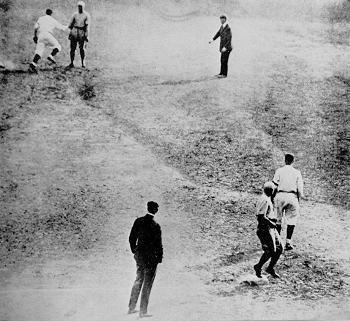 | ||
In baseball, an unassisted triple play occurs when a defensive player makes all three putouts by himself in one continuous play, without his teammates making any assists. Neal Ball was the first to achieve this in Major League Baseball (MLB) under modern rules, doing so on July 19, 1909. For this rare play to be possible there must be no outs in the inning and at least two runners on base. An unassisted triple play usually consists of a hard line drive hit directly at an infielder for the first out, with that same fielder then able to double off one of the base runners and tag a second for the second and third outs.
Contents
In MLB, a total of fifteen players have fielded an unassisted triple play, making this feat rarer than a perfect game. Of these fifteen players, eight were shortstops, five were second basemen and two were first basemen. The Cleveland Indians are the only franchise to have three players achieve the feat while on their roster: Ball, Bill Wambsganss and Asdrúbal Cabrera. The shortest time between two unassisted triple plays occurred in May 1927, when Johnny Neun executed the feat less than 24 hours after Jimmy Cooney. Conversely, it took more than 41 seasons after Neun's play before Ron Hansen performed the feat on July 30, 1968, marking the longest span between unassisted triple plays. The last player to make an unassisted triple play is Eric Bruntlett, accomplishing the feat on August 23, 2009. Only Neun and Bruntlett executed unassisted triple plays that ended the game.
Background
Most unassisted triple plays in MLB have taken this form: an infielder catches a line drive (one out), steps on a base to double off a runner (two outs), and then tags another runner on the runner's way to the next base (three outs). The "next base" usually being the same base that the infielder stepped on to record the second out. Infrequently, the order of the last two putouts is reversed.
It is nearly impossible for an unassisted triple play to occur unless the fielder is positioned between the two runners. For this reason, all but two of these plays have been accomplished by middle infielders (second basemen and shortstops). The other two were completed by first basemen, who were able to reach second base before the returning baserunner. For example, after collecting the first two outs, Tigers' first baseman Johnny Neun ignored his shortstop's shouts to throw the ball, and instead ran to second base to get the final out himself. The only unassisted triple play that did not take one of these forms occurred in the 19th century, under rules that are no longer in effect (see below).
It is plausible that a third baseman could complete an unassisted triple play with runners at second and third or with bases loaded, but this has never happened in MLB. Players in other positions (pitcher, catcher, outfielders) completing an unassisted triple play would require unusual confusion or mistakes by the baserunners, or an atypical defensive alignment (for example, repositioning an outfielder as a fifth infielder).
The unassisted triple play, the perfect game, hitting four home runs in one game and five extra-base hits in a game are thus comparable in terms of rarity, but the perfect game and the home run and extra-base hit records require an extraordinary effort along with a fair amount of luck. By contrast, the unassisted triple play is essentially always a matter of luck: a combination of the right circumstances with the relatively simple effort of catching the ball and running in the right direction with it. Troy Tulowitzki said of his feat, "It fell right in my lap", and as WGN-TV sports anchor Dan Roan commented, "That's the way these plays always happen."
19th century
Modern era (in MLB)
Player is active.
